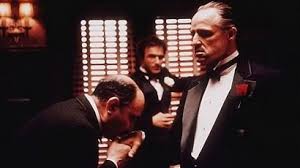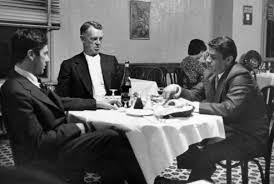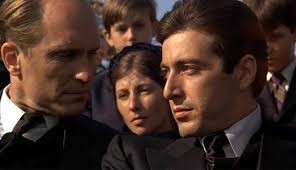The Godfather (1972)
The Three (3) actors I’d like to focus on in this week’s blog are: Marlon Brando, Al Pacino and Robert Duvall. While Robert Duvall wasn’t a primary player in the film I like his acting style and think he deserves kudos for his role as the Corleone lawyer.
Marlon Brando– (“Don” Vito Corleone)I would characterize him as Personality from the text. Method Actor, I believe the reason he fits this type of acting would be from the first scene in the movie he needed to portray his character as a strong personality of a Mafia boss. So he took it upon himself to stuff cotton balls in his jaws to give his look of a bulldog and to help with a slight change in his voice. Even our reading material identified him as a method actor. He’s a consummate professional in all films he’s ever starred in. As an actor, he portrays all his characters with creativity. Throughout his professional career he took on many rolls from Drama, musicals and comedy (The Freshman, 1990). He played a good guy in conflict with the Union as a Long Shoreman. He played a classic historic figure in Julius Caesar as Marc Antony. This film was directed by John Huston. I’m sure lots of folks don’t remember his role as Jor El in the 70’s Superman movie. It was a brief appearance but at the time his name and appearance was a boost for that movie.
Young actor Marlon Brando, Google images.
Marlon Brando as Jor El, Superman Movie 1978
I could go on and on about Brando because he is one of my favorite actors. He had many film successes and many flops right along with the successes. But one thing about Brando and his movies is that even if the film was a failure his acting was always excellent.
Al Pacino– (Michael Corleone) Method Actor/Personality, I think he fits this type of acting, because the way he present about himself or his character with the camera that he seems to draw on past experiences to bring the character to life. Especially the scene at the restaurant and his character in the scene when he goes Las Vegas, it’s the scene in the motel room where he tells his brother never go against the family. Michael exudes stoicism, strength and a position of authority in his interactions with fellow mafia members as well as his family. Most scenes of Michael after taking over the family business is him as a serious man. I think Michael doesn’t crack a smile in the rest of the movie.
Al Pacino roles have been varied through his career like Brando. Pacino has played a mobster (The Godfather, The Godfather, Part II), A cop who blows the whistle on a corrupt police force in Serpico, a blind veteran (Scent of a Woman) and the Devil in Devils Advocate.
Col. Slade, Scent of a Woman 1992, Google Images
Devil’s Advocate, 1997 Google Images
Pacino’s career has been long and he’s played several roles but he’s probably done his best work when playing in dramas or crime movies. He has moved away from the mobster role in later years but in Hollywood as you age you need to try to stay on top with roles offered.
Robert Duvall—(Tom Hagen) Character Actor. Duvall would be classified as a Character actor in Hollywood. In almost all his movies he’s been cast in the supporting role or as a minor character. In the Godfather movie he plays Tom who was taken in by the Corleone family and educated. He’s their lawyer. In the movie his scenes aren’t frequent or major but he ties up to the business. This role would be considered a supporting character role. Duvall has played a character most of his career probably due to the fact that he didn’t have the “look” for a leading man. He has gained acclaim for roles he played later in life like Gus MacCrae in the mini Series Lonesome Dove (1989), General Lee in Gods and Generals (2003) and most currently in The Judge(2014) as Joseph Palmer.
Sources:
Internet Movie Database (IMDB)
Picture Stills courtesy of Google Images
Classroom Textbook: Film: From watching to Seeing, 2nd Edition, 2014 Bill Goodykoontz, Christopher P Jacobs, Bridgepoint Education Inc.











